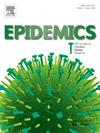Estimating nosocomial transmission of micro-organisms in hospital settings using patient records and culture data
IF 2.4
3区 医学
Q2 INFECTIOUS DISEASES
引用次数: 0
Abstract
Pathogenic bacteria are a major threat to patient health in hospitals. Here we leverage electronic health records from a major New York City hospital system collected during 2020–2021 to support simulation inference of nosocomial transmission and pathogenic bacteria detection using an agent-based model (ABM). The ABM uses these data to inform simulation of importation from the community, nosocomial transmission, and patient spontaneous decolonization of bacteria. We additionally use patient clinical culture results to inform an observational model of detection of the pathogenic bacteria. The model is coupled with a Bayesian inference algorithm, an iterated ensemble adjustment Kalman filter, to estimate the likelihood of detection upon testing and nosocomial transmission rates. We evaluate parameter identifiability for this model-inference system and find that the system is able to estimate modelled nosocomial transmission and effective sensitivity upon clinical culture testing. We apply the framework to estimate both quantities for seven prevalent bacterial pathogens: Escherichia coli, Klebsiella pneumoniae, Pseudomonas aeruginosa, Staphylococcus aureus (both sensitive, MSSA, and resistant, MRSA, phenotypes), Enterococcus faecium and Enterococcus faecalis. We estimate that nosocomial transmission for E. coli is negligible. While bacterial pathogens have different importation rates, nosocomial transmission rates were similar among organisms, except E. coli. We also find that estimated likelihoods of detection are similar for all pathogens. This work highlights how fine-scale patient data can support inference of the epidemiological properties of micro-organisms and how hospital traffic and patient contact determine epidemiological features. Evaluation of the transmission potential for different pathogens could ultimately support the development of hospital control measures, as well as the design of surveillance strategies.
利用病人记录和培养数据估计医院环境中微生物的院内传播
致病菌是医院病人健康的主要威胁。在这里,我们利用2020-2021年期间从纽约市主要医院系统收集的电子健康记录,使用基于代理的模型(ABM)支持医院传播和致病菌检测的模拟推断。ABM使用这些数据来模拟从社区输入、医院传播和患者自发的细菌去菌落。此外,我们使用患者临床培养结果来告知病原菌检测的观察模型。该模型与贝叶斯推理算法、迭代集合调整卡尔曼滤波相结合,以估计检测检测的可能性和医院传播率。我们评估了该模型推理系统的参数可辨识性,并发现该系统能够估计模拟的医院传播和临床培养测试的有效敏感性。我们应用该框架来估计7种流行的细菌病原体的数量:大肠杆菌、肺炎克雷伯菌、铜绿假单胞菌、金黄色葡萄球菌(敏感型,MSSA,耐药型,MRSA,表型)、屎肠球菌和粪肠球菌。我们估计大肠杆菌的医院传播是可以忽略不计的。虽然细菌病原体有不同的输入率,但除大肠杆菌外,微生物之间的医院传播率相似。我们还发现,所有病原体的检测估计可能性是相似的。这项工作强调了精细尺度的患者数据如何支持微生物流行病学特性的推断,以及医院交通和患者接触如何决定流行病学特征。对不同病原体传播潜力的评估最终可支持医院控制措施的制定以及监测战略的设计。
本文章由计算机程序翻译,如有差异,请以英文原文为准。
求助全文
约1分钟内获得全文
求助全文
来源期刊

Epidemics
INFECTIOUS DISEASES-
CiteScore
6.00
自引率
7.90%
发文量
92
审稿时长
140 days
期刊介绍:
Epidemics publishes papers on infectious disease dynamics in the broadest sense. Its scope covers both within-host dynamics of infectious agents and dynamics at the population level, particularly the interaction between the two. Areas of emphasis include: spread, transmission, persistence, implications and population dynamics of infectious diseases; population and public health as well as policy aspects of control and prevention; dynamics at the individual level; interaction with the environment, ecology and evolution of infectious diseases, as well as population genetics of infectious agents.
 求助内容:
求助内容: 应助结果提醒方式:
应助结果提醒方式:


